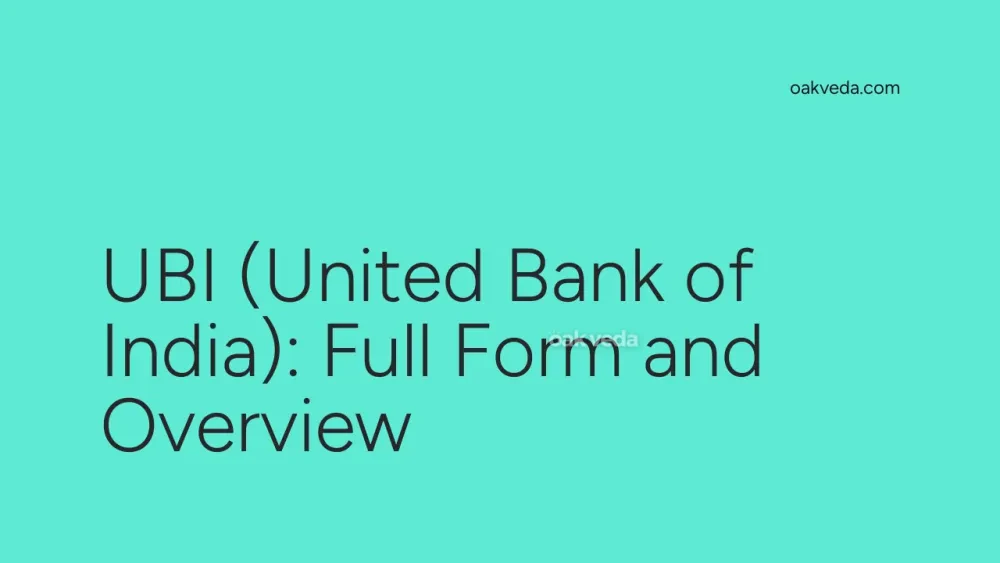
What is the Full Form of UBI?
The full form of UBI is United Bank of India. This abbreviation represents one of India's prominent public sector banks that played a significant role in the country's financial landscape for several decades.
What is United Bank of India?
United Bank of India was a major Indian government-owned bank headquartered in Kolkata, West Bengal. Established through the merger of four Bengali banks in 1950, UBI grew to become a significant player in the Indian banking sector, particularly in Eastern India.
Origin and Development of United Bank of India
The history of United Bank of India is a testament to the evolution of India's banking sector:
- 1950: UBI was formed by merging four Bengali banks: Comilla Banking Corporation, Bengal Central Bank, Comilla Union Bank, and Hooghly Bank.
- 1961: UBI expanded by amalgamating with Cuttack Bank and Tezpur Industrial Bank.
- 1969: On July 19, the Government of India nationalized UBI along with 13 other major commercial banks.
- 1973: UBI acquired Hindustan Mercantile Bank.
- 1976: Narang Bank of India, founded in 1943 in Gujarat, was absorbed by UBI.
How did United Bank of India work?
UBI operated with a three-tier organizational structure:
- Headquarters in Kolkata
- Regional offices across India
- Numerous branches and subsidiaries
The bank focused on providing a wide range of banking services, including:
- Retail banking
- Corporate banking
- International banking
- Rural and agricultural finance
Functions of United Bank of India
As a public sector bank, UBI performed several crucial functions:
- Deposit Mobilization: Encouraging savings and offering various deposit schemes.
- Credit Disbursement: Providing loans to individuals, businesses, and industries.
- Financial Inclusion: Extending banking services to underserved and rural areas.
- Government Banking: Acting as an agent for government transactions and schemes.
- Foreign Exchange Services: Facilitating international trade and remittances.
Applications of United Bank of India
UBI's services found applications across various sectors:
- Agriculture: Providing crop loans and supporting rural development.
- Small and Medium Enterprises (SMEs): Offering financial support to boost entrepreneurship.
- Education: Providing student loans to support higher education.
- Housing: Offering home loans to promote homeownership.
- Corporate Sector: Extending credit facilities to large corporations and industries.
Features of United Bank of India
Some notable features of UBI included:
- Extensive Branch Network: Over 2,000 branches across India.
- Digital Banking: Offering internet and mobile banking services.
- Specialized Products: Tailored financial products for different customer segments.
- Government Schemes: Active participation in implementing various government-sponsored schemes.
- Regional Focus: Strong presence in Eastern India, particularly West Bengal.
Benefits of United Bank of India
UBI's presence in the banking sector offered several benefits:
- Financial Inclusion: Bringing banking services to remote and rural areas.
- Economic Development: Supporting local businesses and industries.
- Employment Generation: Creating job opportunities in the banking sector.
- Social Banking: Implementing government schemes for social welfare.
- Customer-Centric Approach: Offering personalized services to meet diverse customer needs.
Limitations or Challenges of United Bank of India
Despite its contributions, UBI faced several challenges:
- Non-Performing Assets (NPAs): High levels of bad loans affected the bank's financial health.
- Technological Adaptation: Keeping pace with rapidly evolving digital banking trends.
- Competition: Facing stiff competition from private and foreign banks.
- Operational Efficiency: Streamlining operations to improve profitability.
- Regulatory Compliance: Adhering to evolving banking regulations and norms.
Future Developments: Merger and Beyond
In a significant development, United Bank of India underwent a major transformation:
- 2020 Merger: On April 1, 2020, UBI was merged with Punjab National Bank (PNB) and Oriental Bank of Commerce (OBC) as part of the government's bank consolidation plan.
- Post-Merger Entity: The merged entity retained the name Punjab National Bank, becoming the second-largest public sector bank in India.
- Enhanced Capabilities: The merger aimed to create a stronger, more competitive bank with improved operational efficiency and wider reach.
FAQs on UBI Full Form
-
What is the full form of UBI in banking? The full form of UBI in banking is United Bank of India.
-
When was United Bank of India established? United Bank of India was established in 1950 through the merger of four Bengali banks.
-
Where was the headquarters of United Bank of India located? The headquarters of United Bank of India was located in Kolkata, West Bengal.
-
Is United Bank of India still operational as an independent bank? No, United Bank of India merged with Punjab National Bank and Oriental Bank of Commerce in April 2020.
-
What was the significance of UBI in India's banking sector? UBI played a crucial role in financial inclusion and economic development, particularly in Eastern India.
In conclusion, the full form of UBI - United Bank of India - represents a significant chapter in India's banking history. From its inception in 1950 to its merger in 2020, UBI contributed substantially to India's financial landscape. While it no longer exists as an independent entity, its legacy continues through its integration into the larger Punjab National Bank, shaping the future of Indian banking.
You may be interested in:

